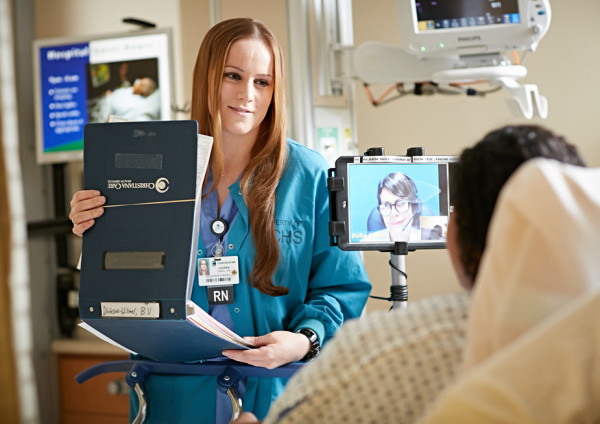Video remote interpretation assists patient care


As an anesthesiologist, Patricia Moore, M.D., is often asked to give an epidural to ease the pain of a woman in labor.
That requires talking to the patient and her loved ones and positioning her body so that a catheter can be administered in her epidural space.
For patients who don’t speak or understand English, that task was much more difficult to accomplish because the patient was often communicating with an interpreter via telephone.
“Her family and I often couldn’t hear the translator on speaker phone,” Dr. Moore said. “And it’s difficult to position a patient for an epidural when she is on the phone.”
Now, a video remote interpreting (VRI) system is making communication more effective and accessible. In VRI, the patient and a qualified interpreter talk with one another via iPad.
“The patient can see the interpreter, and the interpreter can see the patient,” said Jacqueline Ortiz, MPhil, director of Cultural Competence and Language Services. “It’s the second-best thing to an in-person interpreter.”
Implemented through the Learning Institute’s Center for Diversity & Inclusion, Cultural Competence and Equity, the VRI pilot program was launched March 3 in three areas, each with a specific need:
- The Breast Center at the Helen F. Graham Cancer Center & Research Institute provides care to women from many different ethnic groups through their targeted outreach efforts. VRI provides efficient solutions that are also cost-effective.
- In the Periop and Post-Anesthesia Care Unit (PACU) at Wilmington Hospital, surgeries typically begin early in the morning, before staff interpreters start work. Most interactions are short, discrete encounters with lag time in between, an inefficient scenario for in-person interpreters.
- In Triage and Labor and Delivery, remote technology helps to ensure 24/7 availability of interpreter services. “Babies come when they want to and it’s difficult to predict,” Ortiz said.
Dr. Moore says VRI is a win-win, benefitting patients and providers.
“I have a very short period of time in order to establish a relationship with my patients and give them a sense of confidence,” she said. “With VRI, everyone can see the interpreter, everyone hears the same message.”
The system is light and portable, essentially an iPad mounted on a pole. It works a bit like Skype in that both speakers can see one another.
VRI also offers the capability to provide interpreting in more languages. Currently, Christiana Care’s language services staff of 15 provides interpreting in American Sign Language, Spanish and Mandarin; 18 other languages are offered through the Language Interpreters Network Christiana Care (LINCC), in which bilingual employees pass a rigorous qualification process.
“The Christiana Care Way is to treat patients as respectful, expert, caring partners in their health,” Ortiz said. “We can’t do that if we cannot understand each other accurately and completely.”
Video remote interpreting helps us to provide culturally competent care. I see how the patients relax the instant they see the interpreter’s face.
Lauren Cahill, RN, BC, often schedules staff interpreters in her work as a periop nurse. VRI adds an extra layer of flexibility.
“Everyone who communicates with the patient has access to interpretation with the click of a button,” she said. “There’s no worry about interpretation if cases are added at the last minute.”
The pilot runs through July and will be evaluated through surveys. Ortiz notes that VRI has the potential for widespread use, such as allowing visiting nurses to bring portable, word-for-word interpretation services to patients’ homes.
“It helps us to provide culturally competent care,” Cahill said. “I see how the patients relax the instant they see the interpreter’s face.”